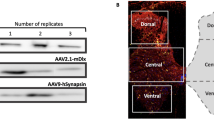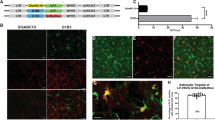Abstract
We have produced high-titre HIV-1 green fluorescent protein-expressing lentiviral (LV) vectors pseudotyped with strain 3908 Venezuelan equine encephalitis virus glycoprotein (VEEV-G) and used them to study transduction of: (1) rat embryonic motor neuron (MN) and striatal neuron primary cultures, (2) differentiated MN cell line NSC-34 and (3) adult rat striatum. In primary neuronal cultures, transduction with VEEV-G-pseudotyped LV was more efficient and more neuronal than with vesicular stomatitis virus glycoprotein (VSV-G)-pseudotyped LV. In NSC-34 cells clear retrograde transport of VEEV-G vector particles was observed. In the striatum at the injection site, transduction with the VEEV-G vectors driven by cytomegalovirus or phosphoglycerate kinase promoters exhibited a distinct neuronal tropism with no microglial and only a minor astroglial component, superior to that obtained with VSV-G-pseudotyped LV, irrespective of the promoter used. Neuronal transduction efficiency increased over time. Distal to the injection site transduction of mitral cells in the olfactory bulb, thalamic neurons and dopaminergic neurons in the substantia nigra pars compacta was detected. This, together with observations of retrograde axonal trafficking in vitro indicates that these vectors also possess low level of retrograde neuronal transduction capability in vivo. In this study, we demonstrate both strong neurotropism as well as sustainability of expression and minimal host immune response in vivo, making the VEEV-G-pseudotyped LV vectors potentially useful for gene therapy of neurodegenerative diseases.
This is a preview of subscription content, access via your institution
Access options
Subscribe to this journal
Receive 12 print issues and online access
$259.00 per year
only $21.58 per issue
Buy this article
- Purchase on Springer Link
- Instant access to full article PDF
Prices may be subject to local taxes which are calculated during checkout




Similar content being viewed by others
References
Bartz SR, Rogel ME, Emerman M . Human immunodeficiency virus type 1 cell cycle control: Vpr is cytostatic and mediates G2 accumulation by a mechanism which differs from DNA damage checkpoint control. J Virol 1996; 70: 2324–2331.
Canivet M, Hoffman AD, Hardy D, Sernatinger J, Levy JA . Replication of HIV-1 in a wide variety of animal cells following phenotypic mixing with murine retroviruses. Virology 1990; 178: 543–551.
Chesebro B, Wehrly K, Maury W . Differential expression in human and mouse cells of human immunodeficiency virus pseudotyped by murine retroviruses. J Virol 1990; 64: 4553–4557.
Cronin J, Zhang XY, Reiser J . Altering the tropism of lentiviral vectors through pseudotyping. Curr Gene Ther 2005; 5: 387–398.
Lusso P, di Marzo Veronese F, Ensoli B, Franchini G, Jemma C, DeRocco SE et al. Expanded HIV-1 cellular tropism by phenotypic mixing with murine endogenous retroviruses. Science 1990; 247: 848–852.
Spector DH, Wade E, Wright DA, Koval V, Clark C, Jaquish D et al. Human immunodeficiency virus pseudotypes with expanded cellular and species tropism. J Virol 1990; 64: 2298–2308.
Zhu ZH, Chen SS, Huang AS . Phenotypic mixing between human immunodeficiency virus and vesicular stomatitis virus or herpes simplex virus. J Acquir Immune Defic Syndr 1990; 3: 215–219.
Mazarakis ND, Azzouz M, Rohll JB, Ellard FM, Wilkes FJ, Olsen AL et al. Rabies virus glycoprotein pseudotyping of lentiviral vectors enables retrograde axonal transport and access to the nervous system after peripheral delivery. Hum Mol Genet 2001; 10: 2109–2121.
Wong LF, Azzouz M, Walmsley LE, Askham Z, Wilkes FJ, Mitrophanous KA et al. Transduction patterns of pseudotyped lentiviral vectors in the nervous system. Mol Ther 2004; 9: 101–111.
Federici T, Kutner R, Zhang XY, Kuroda H, Tordo N, Boulis NM et al. Comparative analysis of HIV-1-based lentiviral vectors bearing lyssavirus glycoproteins for neuronal gene transfer. Genet Vaccines Ther 2009; 7: 1.
Kato S, Inoue K, Kobayashi K, Yasoshima Y, Miyachi S, Inoue S et al. Efficient gene transfer via retrograde transport in rodent and primate brains using a human immunodeficiency virus type 1-based vector pseudotyped with rabies virus glycoprotein. Hum Gene Ther 2007; 18: 1141–1151.
Mentis GZ, Gravell M, Hamilton R, Shneider NA, O’Donovan MJ, Schubert M . Transduction of motor neurons and muscle fibers by intramuscular injection of HIV-1-based vectors pseudotyped with select rabies virus glycoproteins. J Neurosci Methods 2006; 157: 208–217.
Mitrophanous K, Yoon S, Rohll J, Patil D, Wilkes F, Kim V et al. Stable gene transfer to the nervous system using a non-primate lentiviral vector. Gene Ther 1999; 6: 1808–1818.
Kolokoltsov AA, Weaver SC, Davey RA . Efficient functional pseudotyping of oncoretroviral and lentiviral vectors by Venezuelan equine encephalitis virus envelope proteins. J Virol 2005; 79: 756–763.
Greene IP, Paessler S, Austgen L, Anishchenko M, Brault AC et al. Envelope glycoprotein mutations mediate equine amplification and virulence of epizootic venezuelan equine encephalitis virus. J Virol 2005; 79: 9128–9133.
Phillpotts RJ, Jones LD, Howard SC . Monoclonal antibody protects mice against infection and disease when given either before or up to 24 h after airborne challenge with virulent Venezuelan equine encephalitis virus. Vaccine 2002; 20: 1497–1504.
Ludwig GV, Kondig JP, Smith JF . A putative receptor for Venezuelan equine encephalitis virus from mosquito cells. J Virol 1996; 70: 5592–5599.
Zufferey R, Donello JE, Trono D, Hope TJ . Woodchuck hepatitis virus posttranscriptional regulatory element enhances expression of transgenes delivered by retroviral vectors. J Virol Apr 1999; 73: 2886–2892.
Salinas S, Bilsland LG, Henaff D, Weston AE, Keriel A, Schiavo G et al. CAR-associated vesicular transport of an adenovirus in motor neuron axons. PLoS Pathog 2009; 5: e1000442.
Cashman NR, Durham HD, Blusztajn JK, Oda K, Tabira T, Shaw IT et al. Neuroblastoma x spinal cord (NSC) hybrid cell lines resemble developing motor neurons. Dev Dyn 1992; 194: 209–221.
Deinhardt K, Berninghausen O, Willison HJ, Hopkins CR, Schiavo G . Tetanus toxin is internalized by a sequential clathrin-dependent mechanism initiated within lipid microdomains and independent of epsin1. J Cell Biol 2006; 174: 459–471.
Carpentier DC, Vevis K, Trabalza A, Georgiadis C, Ellison SM, Asfahani RI et al. Enhanced pseudotyping efficiency of HIV-1 lentiviral vectors by a rabies/vesicular stomatitis virus chimeric envelope glycoprotein. Gene Ther 2012; 19: 761–774.
Jakobsson J, Nielsen TT, Staflin K, Georgievska B, Lundberg C . Efficient transduction of neurons using Ross River glycoprotein-pseudotyped lentiviral vectors. Gene Ther 2006; 13: 966–973.
Kahl CA, Marsh J, Fyffe J, Sanders DA, Cornetta K . Human immunodeficiency virus type 1-derived lentivirus vectors pseudotyped with envelope glycoproteins derived from Ross River virus and Semliki Forest virus. J Virol 2004; 78: 1421–1430.
Sharkey CM, North CL, Kuhn RJ, Sanders DA . Ross River virus glycoprotein pseudotyped retroviruses and stable cell lines for their production. J Virol 2001; 75: 2653–2659.
Morizono K, Bristol G, Xie YM, Kung SK, Chen IS . Antibody-directed targeting of retroviral vectors via cell surface antigens. J Virol 2001; 75: 8016–8020.
Poluri A, Ainsworth R, Weaver SC, Sutton RE . Functional pseudotyping of human immunodeficiency virus type 1 vectors by Western equine encephalitis virus envelope glycoprotein. J Virol 2008; 82: 12580–12584.
Strang BL, Takeuchi Y, Relander T, Richter J, Bailey R et al. Human immunodeficiency virus type 1 vectors with alphavirus envelope glycoproteins produced from stable packaging cells. J Virol 2005; 79: 1765–1771.
Froelich S, Tai A, Kennedy K, Zubair A, Wang P . Pseudotyping lentiviral vectors with AURA virus envelope glycoproteins for DC-SIGN-mediated transduction of dendritic cells. Hum Gene Ther 2011; 22: 1281–1291.
Kang Y, Stein CS, Heth JA, Sinn PL, Penisten AK, Staber PD et al. In vivo gene transfer using a nonprimate lentiviral vector pseudotyped with Ross River Virus glycoproteins. J Virol 2002; 76: 9378–9388.
Malygin AA, Bondarenko EI, Ivanisenko VA, Protopopova EV, Karpova GG, Loktev VB . C-terminal fragment of human laminin-binding protein contains a receptor domain for venezuelan equine encephalitis and tick-borne encephalitis viruses. Biochemistry 2009; 74: 1328–1336.
de Almeida LP, Zala D, Aebischer P, Déglon N . Neuroprotective effect of a CNTF-expressing lentiviral vector in the quinolinic acid rat model of Huntington’s disease. Neurobiol Dis 2001; 8: 433–446.
Strauss JH, Strauss EG . The alphaviruses: gene expression, replication, and evolution. Microbiol Rev 1994; 58: 491–562.
Mochizuki H, Schwartz JP, Tanaka K, Brady RO, Reiser J . High-titer human immunodeficiency virus type 1-based vector systems for gene delivery into nondividing cells. J Virol 1998; 72: 8873–8883.
Kutner RH, Zhang XY, Reiser J . Production, concentration and titration of pseudotyped HIV-1-based lentiviral vectors. Nat Protoc 2009; 4: 495–505.
Olsson M, Campbell K, Wictorin K, Björklund A . Projection neurons in fetal striatal transplants are predominantly derived from the lateral ganglionic eminence. Neuroscience 1995; 69: 1169–1182.
Acknowledgements
We would like to thank our ex-MSc students Petros Patsali, Daniel M Lipiski and Joanne Crowe for technical contributions to this study. Dr Robert A. Davey, University of Texas for giving us the VEEV-G TRD and 3908 plasmids. Professor Richard Reynolds and Dr Owain Howell for the use of and help with fluorescence microscopy to document histological staining of brain sections. We would also like to thank Dr Egle Solito and Enrico Cristante for letting us use several antibodies. This work was partly supported by Imperial College London starting funds to NDM and a Seventh Framework Programme European Research Council Advanced Grant, no: 23314 to NDM supporting AT, IE, JH and SME.
Author information
Authors and Affiliations
Corresponding author
Ethics declarations
Competing interests
The authors declare no conflict of interest.
Additional information
Supplementary Information accompanies the paper on Gene Therapy website
Rights and permissions
About this article
Cite this article
Trabalza, A., Georgiadis, C., Eleftheriadou, I. et al. Venezuelan equine encephalitis virus glycoprotein pseudotyping confers neurotropism to lentiviral vectors. Gene Ther 20, 723–732 (2013). https://doi.org/10.1038/gt.2012.85
Received:
Revised:
Accepted:
Published:
Issue Date:
DOI: https://doi.org/10.1038/gt.2012.85
Keywords
This article is cited by
-
Tropism, intracerebral distribution, and transduction efficiency of HIV- and SIV-based lentiviral vectors after injection into the mouse brain: a qualitative and quantitative in vivo study
Histochemistry and Cell Biology (2017)
-
Specific Retrograde Transduction of Spinal Motor Neurons Using Lentiviral Vectors Targeted to Presynaptic NMJ Receptors
Molecular Therapy (2014)



